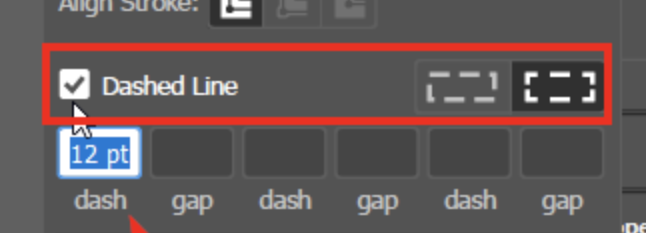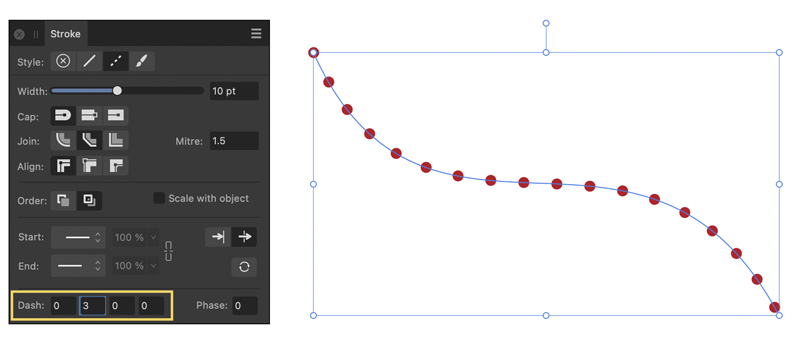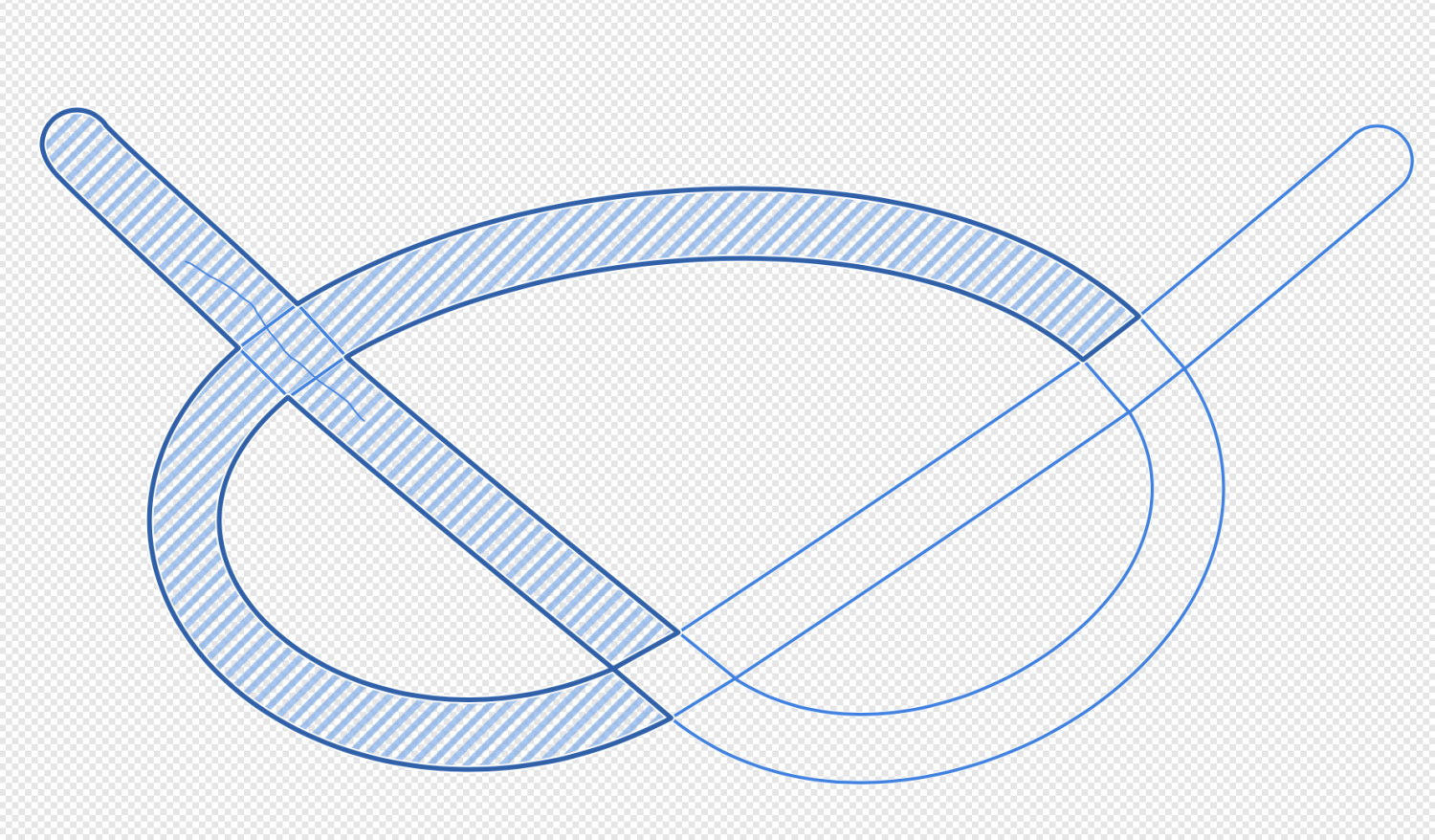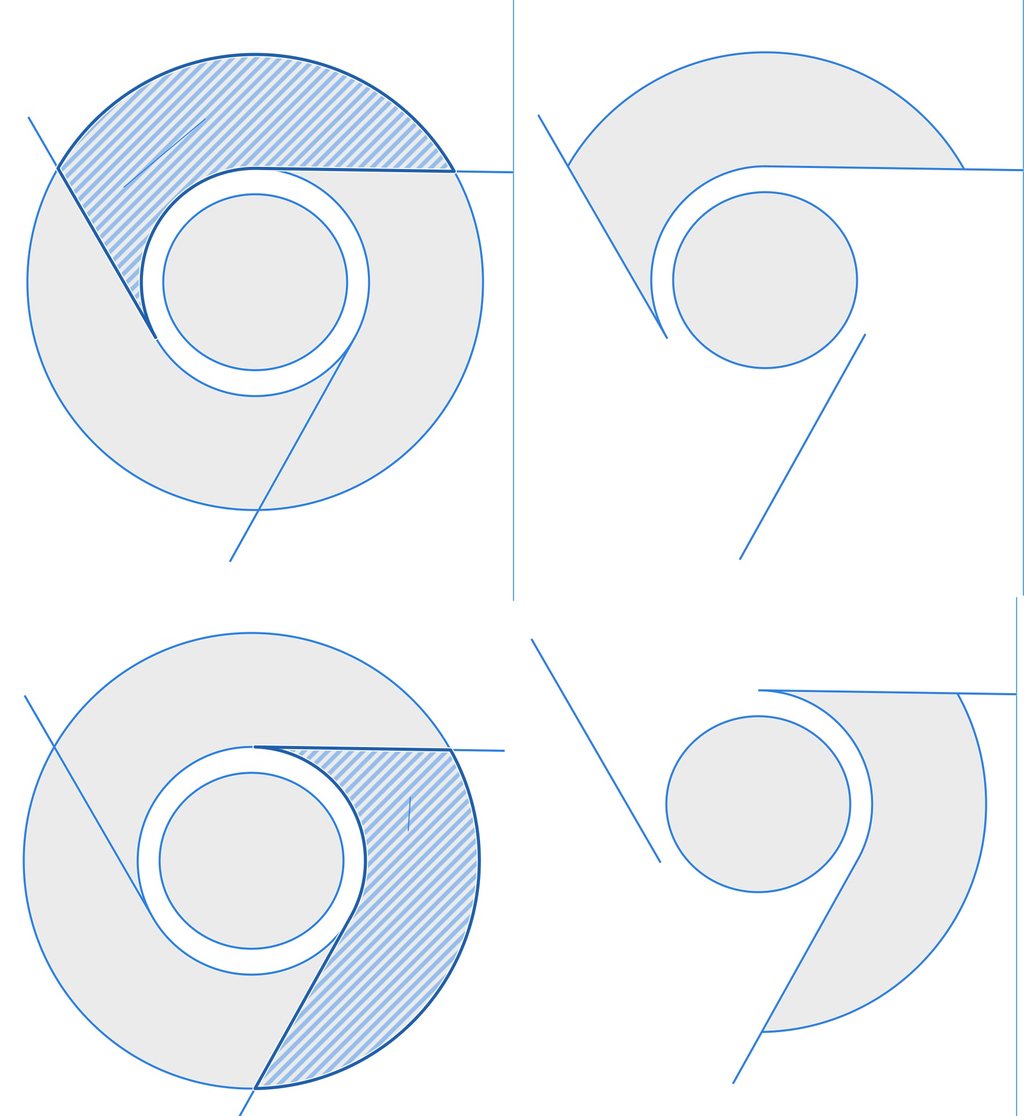
fjunk
Members-
Posts
101 -
Joined
-
Last visited
Everything posted by fjunk
-
This is how it's done in Illustator: If copyright is the issue, then how about, at least, a tooltip? If a picture is worth 1000 words, then words might at least be worth a few brain cells (of memory). Here's how dots are done in Affinity Designer (which mirrors how it's done in Illustrator. But, again, you have to practice it and remember it. The less I, or anyone else, has to go somewhere else to find the answer: Illustrator included, is that much more time that can be dedicated to designing. There are those for whom this is no big deal. For me, the less I have to remember the better. I have a pretty decent memory, at 68. That doesn't mean I look forward to yet another thing to have to remember. And, these days, every day, that's a lot. Add to that every other program (Blender for example is shortcut intensive). Don't want to, there are far more expensive alternatives. Affinity Designer, is truly a bargain, for what it does, how well it does it, and for the price. Doesn't mean there's not room for improvement. Thanks.
-
That it may be, but, it's been true since forever: "A picture is worth a thousand words." Here considerably fewer. But, why ask people to think that hard, which admittedly isn't, when you could give them a drop down list of choices (as well, perhaps for those who want the additional mathematical customization). When something simple is desired, in the grand scheme of things, that's a lot easier than working out the math. Maybe even some way to macro the method so as not to have to repeat it. I know there's a way to copy styles. Maybe, I missed it, and that applies to dashed or dotted lines as well. Still, nothing beats point and click.
-
Line Strokes - Dashed / Dotted
fjunk replied to fjunk's topic in Feedback for the Affinity V2 Suite of Products
Yes. It works similarly in Inkscape. -
Instead of playing math with strokes (or logic, take your pic) how about a simple dropdown list of example possibilities to choose from, comparable to Inkscape? The option can still be there for those who want or need to play with the numbers. For those of us just looking for a SIMPLE dotted or dashed line of one kind or another, there would be that. Or, maybe better yet, just combine the two ideas, still provide the numerical examples, but, alongside the examples, as explained above. Like, idunno, Styles, or QuickFX. Something we're already used to. Maybe?
-
There used to be a very visible indicator of what this does "Dash". It's missing in 2.2. Always used it? Know what you're looking for and where? Not a problem. Also, in addition to playing math with strokes (or logic, take your pic) how about a simple dropdown list of example possibilities to choose from, comparable to Inkscape. The option can still be there for those who want or need to play with the numbers. For those of us just looking for a SIMPLE dotted or dashed line of one kind or another, there would be that. Or, maybe better yet, just combine the two ideas, still provide the numerical examples, but, alongside the examples, as explained above. Like, idunno, Styles, or QuickFX. Something we're already used to. Maybe?
-
Ok, I've looked at everything except Publisher. Even as Publisher's explained, that I can tell, the patterns are within a square. PaintStorm Studio and Procreate work predominantly with bitmaps and leave little room for designing outside the "box". VectorStyler comes closest to Illustrator, has many creation and customization options. I tried playing around with dynamic changes and that didn't work so well for me. Affinity Designer has videos, as does Illustrator and Procreate. VectorStyler could benefit greatly from more Youtube videos. A thousand words really doesn't compare to a show'n'tell video. Haven't looked in the VectorStyler Forum yet. I don't think, maybe I'm wrong, would like to be, that Affinity Designer for that matter can create Styles or Presets, in Designer's case, I guess, swatches for Seamless Patterns. Vector Styler can. Seems VectorStyler ($ 99 when I bought it. Even that compared against an Illustrator subscription is cheap.) and Designer would make a complementary team, but, VectorStyler is not as friendly as Designer. Nor does it have the long history, tutorials, videos, and user base that Inkscape does. I like tinkering with it for it's filters, blends - comparable to Illustrator, and Seamless Patterns - also comparable to Illustrator. Could prove useful for laying down a pattern, exporting it into Designer and playing around with it there as well. VectorStyler Patterns documentation: https://www.vectorstyler.com/documentation/patterns/ Symbols, Styles and Presets: https://www.vectorstyler.com/documentation/symbols/ Blends: https://www.vectorstyler.com/documentation/blending/ and Effects: https://www.vectorstyler.com/documentation/shapeeffects/ VectorStyler has a Shape Builder Tool as well, but, I think Affinity Designer's is better. Programmatic vs Procedural, when done right, and Illustrator certainly seems to have a corner on that market, can be a real productivity boost that doesn't get in the way of creation. Vector Styler and Inkscape both do well in that regard. The G'Mic tool for Gimp is another step in that direction for bitmaps. I haven't been able to get it to work on my Mac, but Krita has it built in (and working) on a Mac. Just some other possibilities.
-
The process in both Procreate as well as Affinity is Labor Intensive compared to Adobe Illustrator. And changing from one means Brick to Hexagon (for example) to another is much simpler. There are more options available at a click. Trying to get to the same points in Affinity Designer OR Procreate is just a far more labor intensive process. For AI, for that matter, this process goes back to 2012, CS6. Which means they've had it for awhile. Affinity Designer, to be fair, hasn't been out that long by comparison - 2018 vs 2012 (for the AI Seamless Pattern process currently in use). It can be done using Affinity Designer or Procreate, but, with AI, it's so much simpler, flexible. If you watch the video, it's readily apparent. It's not that it can't be done. It's that it can be done better. Just as with Shape Builder. Adding it to Affinity Designer made doing the same things that used to be done without it so much easier, simpler. Right now, it's a bit of a kludge. There's room for improvement.
-
Affinity Designer could do better: Adobe Illustrator (2 months ago (Recent)): Not sure how Procreate does it or how it’s better than or just as good as Affinity Designer (for the iPad). What Adobe Illustrator shows is that it could be much better. I realize fully that it’s not the tool that makes the difference, it’s the user. And, I’m not much of a user. That being said, better tools make for better use regardless of the user. Flint and wood shavings worked just fine before matches and matches before lighters. A better tool might not make ineffective users that much better overnight. It would make the process a lot easier. And, that would make good users, great users, and users like me, would make their lives easier in the process. Adobe Illustrator demonstrates what could be. And if they’re doing it, that means copycats could do it as well. Probably not the same way, copyright and all that, but, better, their own way. In the meantime, there’s what currently works with Affinity Designer. But, if they could do shape builder, they can do better seamless tiles. And better seamless tiles would improve process and quality. A good thing, yes?
-
Ok, after some digging, I created this file: and created this template (adjustable) AFD2: WS_V2_Offset2b_REPEAT 12000px.aftemplate from info in this video:
-
If this is so doggoned, dingdanged easy to do, why not just create a Seamless Tile Template and bundle it with Affinity Designer? I'm using AFD2 on a Mac. And damned if I can figure it out. It's supposed to be dirt simple. Tain't working. Apparently it's possible to create an offset Seamless Tile which looks more professional. Better yet, just add Seamless Tile functionality into Affinity Designer. Make it dead simple. Call it something no one would ever think to look for: "Seamless Tile" Tool. Maybe AFD3 or AFD4.
-
There are none there. V1, V2 - none. An idea: There are tutorials on creating seamless patterns. Those that use Live Preview for iPad, and apparently for Windows / Mac as well. Two sources I'm aware of: Liz Kohler Brown: https://www.youtube.com/@LizKohlerBrown and Weronika Salach https://www.youtube.com/@WeronikaSalach I'm guessing, they're somewhat popular. And, not too difficult to do. Why not make it easier and include Boiler templates for this and other comparable tasks in Designer, Photo, Publisher? Add some value.
-
I (thought) I came up with a nifty idea of just Bezier Curving the gaps and then using Shape Builder. That didn't work: As you can see, having lined up the edges of the newly created squares as nearly to seamless as I could discern, Shape Builder still doesn't join them as intended. I tried in three different programs to try to find a simple, straightforward way to fix this. No dice. See for yourself. Maybe I'm missing something. Seems like more work than it oughta be. Update: Nevermind. Selected the whole thing then used Layer / Expand Stroke. That fixed it. After that, it worked as intended. pretzel_WIP_AFD2.afdesignpretzel_WIP_AFD2.afdesign
-
Found these: https://www.printnewspaper.com/newspaper-template/ They give me the broad stroke (blank page) layout, but not any good examples of what a finished format would look like. A mockup would help me get a handle on layout and design. Also this (which provides template / mockups) - saveable as PDF (I believe) haven't tried so may be wrong. But, worth a shot.: https://www.freedomforum.org/todaysfrontpages/
-
As I understand, a Broadsheet Newspaper Template is defined as 12 x 22 in: Source: https://www.thoughtco.com/broadsheet-and-tabloid-newspapers-2074248 "Broadsheet refers to the most common newspaper format, which is typically around 15 inches wide to 20 or more inches long in the U.S., though sizes vary around the world.2 Broadsheet papers tend to feature six columns and employ a traditional approach to news gathering that emphasizes in-depth coverage and a sober writing tone in articles and editorials aimed at fairly affluent, educated readers. Many of the nation's most respected, influential newspapers—The New York Times, The Washington Post, and The Wall Street Journal, for example—are broadsheet papers. In recent years many broadsheets have been reduced in size to cut printing costs. For instance, The New York Times was narrowed by 1 1/2 inches in 2008. Other broadsheet papers, including USA Today, The Los Angeles Times, and The Washington Post, also have been trimmed." I'm guessing Adobe InDesign is the standard for such layouts? Or no? Maybe I'm not seeing them because maybe they're resource intensive? There is a Word (Blank) Template. Publisher is new to me, so, maybe even a little guidance as to where to begin and how to go from there or where to get such (Affinity Publisher) type guidance would help. I understand that likely AI / IDML formats would work. Haven't seen any of the Broadsheet type as described above.
-
Ok, I think I've narrowed it down. It's not my imagination. Here's the results from my most recent iPad - not the newest, but, just before that. The one with magnetic charger that holds the pencil in place: Something that shouldn't be happening. Below are the results from my MacBook Laptop w/Mouse and Keyboard and an older iPad: What I / you would normally expect. I think the problem is in the behavior of the newer iPad but, I'm not sure what would cause it other than perhaps malfunction.
-
Tried on: MacBook - Vectornator - Fail, VectorStyler - Fail, Linux - Inkscape 1.3 (Beta) - With ShapeBuilder - Fail. Here's what worked on Affinity Designer (Macbook - w/Keyboard / Mouse): That took maybe 5 / 10 minutes tops. Maybe it's the iPad. Maybe it's the Designer tools on the iPad. Maybe some combination of the two. It's not the tutorial. When it works, it works. And when it doesn't, it really doesn't maybe for a variety of reasons. Google_Tute_Laptop_Mouse_Worked_AFD2.afdesign
-
I’ve tried this six ways from Sunday on two IPads one with a pencil. One without. On a MacBook laptop with a mouse & keyboard and the results are inconsistent. I try shape builder, for example and it either works as shown or selects all or only one. I try centering the origin and copying 120 degrees with mixed results. Here’s my file. How it SHOULD work is very clear. How it does work, for me is VERY inconsistent. https://www.youtube.com/watch?v=noxDb8qu748 Spent several hours trying to do what should’ve been dead simple. fupduct_iPad.afdesign
-
Recently discovered this about Designer: " Not that i'm aware of, you'd have to do this one by one." I thought I'd ask first. Knowing this, among other problems. I've learned that: 1) Pixel brushes can be installed from other than the Pixel Persona, which is somewhat nice and convenient (or not). Since they are seen, used, and managed from the Pixel Persona, perhaps either an option, at the time of install to switch to Persona or at least to inform the user that they have been installed in Pixel Persona. 2) There, apparently is no way to bulk install Intensity or perhaps other individual brushes as well in a specified category. Attempting to choose them all and install them is interpreted as a desire to install them as one brush. I've got 99 of them. I need and will use them more as 99 individual brushes than I will as one brush with 99 options. It would be nice if this could be adjusted so that it's possible to bulk import brushes as separate brushes. Or at least be asked if the desire is to install them as one brush or individual brushes in a category. 3) ABR brushes. Some Photoshop users aren't nice enough to bundle their brushes. I've got, for example, 155 ABR brushes that want to install as 155 separate Affinity brushes, each in their own category. Each category containing ONE brush. Not exactly what I have in mind. A way to specify, or the ability to bulk install brushes into their own specified category would be a plus and an enormous time and effort time saver. 4) Having discovered this the hard way, I was left to delete all 155 brush categories, one at a time. This involves selecting each brush, one at a time, going to a different menu option to choose "Delete" and then going to a different window to confirm the "Delete". At three clicks, much scrolling between brushes, that's 3 * 155 = 465 mouse clicks and separate moves from one window to the next for all 155 brushes. Perhaps a better way to do this might be to be able to choose, much like the file system bulk or cherry pick and then select "Delete" (same for "Moving" them into a specific category. One by one is exceptionally inefficient. If I can't depend on the Adobe creators of ABR brush sets to better organize them, having better tools for organizing - assets, brushes, and styles, since these problems are not limited to brushes (or Affinity Designer) would be a BIG help. Thank you.










